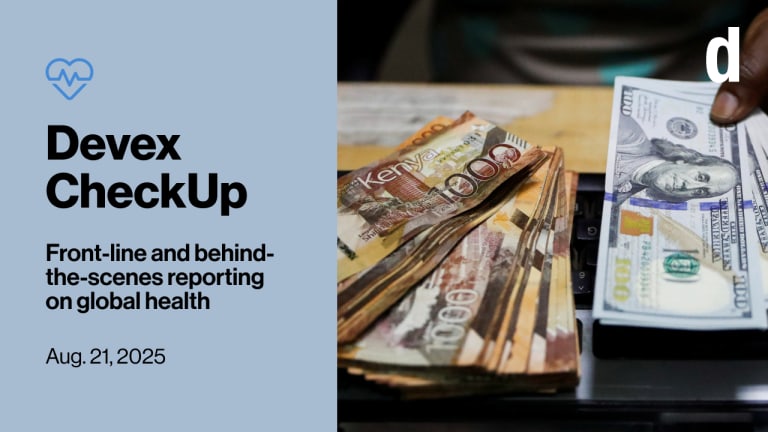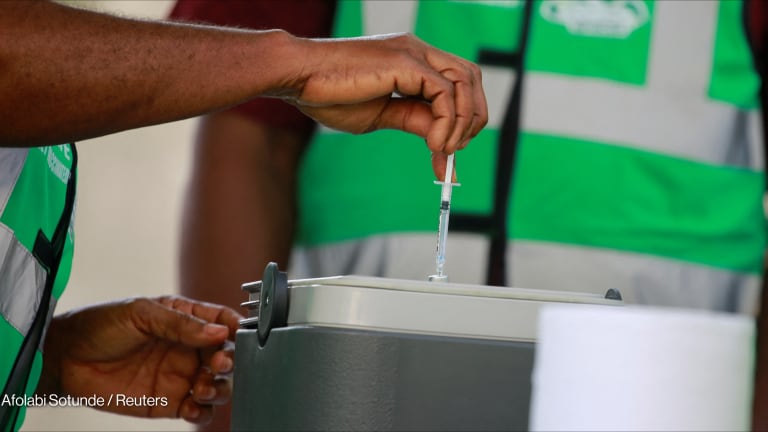
An intermediate level of alert for health emergencies would not solve the problem of countries’ inaction to the World Health Organization recommendations and advice, a review committee of the International Health Regulations has said.
There has been huge interest among WHO member states to introduce a different alert level system for health emergencies that have not yet reached the point of a global crisis, or not yet a public health emergency of international concern. In November 2020, the review committee said it would need to review its relevance.
Join Devex @ WHA 2021
From May 25 to 27, and in a special Devex Pro event on June 1, we will bring you inside the 74th World Health Assembly to answer key questions. Register now.
But in its findings released ahead of the 74th World Health Assembly, the review committee weighed the potential benefits and drawbacks of such an alert level, and recommended instead that WHO be “more assertive” and open in sharing its rapid risk assessments either through its existing Disease Outbreak News or in a new alert notice that could be labeled as “World Alert and Response Notice” or WARN.
This warning notice should inform countries of the actions they should take to prevent an event from becoming a global crisis. In addition, declaring a public health emergency of international concern should come with better communication of its significance and the consequences of declaring one, the committee said.
What are the drawbacks of an intermediate level of alert for health emergencies?
An intermediate level of alert would help raise awareness and signal the need for countries to prepare and respond to a potential international health concern. It may also allow for “better calibration, timeliness, proportionality, regionality and flexibility of response measures”; enable preparation “proportional to the level of risk”; encourage timely communication and transparency among countries without fear of potential travel restrictions linked to the declaration of a public health emergency of international concern; and allow for the mobilization of resources, according to the report.
However, introducing another level of alert doesn’t address the issue of countries’ noncompliance to the provisions in the IHR. It may also further complicate assessments of a health event and its monitoring, which is already a complex exercise, and could even be “misleading if an event still requires global attention but is not (yet) severe or is (still) regionally confined.”
It’s also unclear who determines this alert, and what actions WHO needs to take if this is triggered. It would also require open sharing of information between member states and WHO, for the latter to conduct a proper risk assessment, which is already not consistently happening even under the declaration of a public health emergency of international concern, according to the report.
“Precautionary measures should still be proportional to the perceived threat.”
— findings from a review committee of the International Health RegulationsThe recommendation is consistent with the committee’s interim report to the WHO executive board in January, where its chair said it’s uncertain such a level of alert would result in countries’ earlier actions.
The committee also recommended WHO to share unverified, but publicly available information on a health event that it deems “of significant risk” if a member state does not respond to WHO’s verification requests and information about it is already in the public domain.
This is consistent with the Independent Panel for Pandemic Preparedness and Response’s recommendation for WHO to publish outbreak information immediately without countries’ approval.
A chronology of events in the early days of the outbreak in Wuhan published by the Independent Panel for Pandemic Preparedness and Response showed it took more than a week before China confirmed cases of atypical pneumonia to WHO on Jan. 3, 2020. During this period, a notice issued by the Wuhan Municipal Health Commission was already circulating in online chat groups in China, and picked up by ProMed. Authorities in other countries have also started requesting information from WHO under the IHR.
Declaring a PHEIC or PHEMIC?
There have been questions over WHO’s declaration of COVID-19 as a public health emergency of international concern, and its early advice against travel or trade restrictions on China.
The emergency committee, which advises the WHO director-general on whether to declare a PHEIC, had been divided on its first meeting on Jan. 22, 2020, citing limited information on disease severity and transmissibility. This led WHO chief Tedros Adhanom Ghebreyesus not to declare the outbreak as a global public health emergency until a week later, on Jan. 30, after Tedros’ mission to China.
According to the report of the Independent Panel for Pandemic Preparedness and Response, published Wednesday, WHO could have declared COVID-19 a public health emergency of international concern on Jan. 22, 2020, arguing the outbreak in Wuhan “is likely to have met the criteria to be declared a PHEIC.”
In interviews, the IHR review committee found emergency committee members faced challenges in determining a PHEIC, according to the report. There were questions on what constitutes an “extraordinary event”, and whether they should be basing their advice on the actual spread of disease versus its potential risk of spreading internationally.
In its recommendations, the IHR review committee said emergency committee members “should not be required to reach a consensus,” and that divergent views should be included in the committee’s report.
But it also recommended WHO and member states consider an alternative acronym for a public health emergency of international concern, currently pronounced as “fake,” given the proliferation of fake news. The committee said the PHEIC acronym is not part of the IHR text, and WHO and member states could consider the use of another acronym, such as PHEMIC.
Beyond the acronym, there should be better communication of the definition of a PHEIC, its significance, and the consequences of declaring one, according to the report.
As for travel restrictions, the review committee said there was a “tension” between IHR-guided advice on travel restrictions under a PHEIC and Article 43 of the IHR, which allows countries to implement travel restrictions to protect people’s health. Most of the rationale given by member states in applying travel restrictions during the COVID-19 pandemic was due to the novelty of the SARS-CoV-2 virus, lack of knowledge on the virus and the disease, and countries’ concerns over their limited public health response capacities.
WHO’s initial call for countries to prepare for containment should have included recommendations for quarantine, according to the report. But the committee also concluded that timing affects the effectiveness of travel restrictions — saying it is better if it’s implemented earlier — as well as other contextual factors and the implementation of public health and social measures.
The committee said it is important to consider “the precautionary (or “no regrets”) principle when dealing with a new pathogen, where new evidence is emerging as the situation evolves.” But it also added that “precautionary measures should still be proportional to the perceived threat.”









